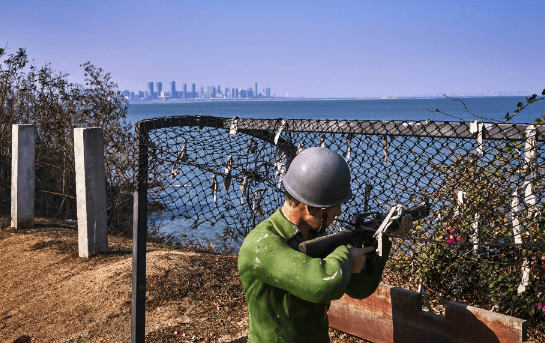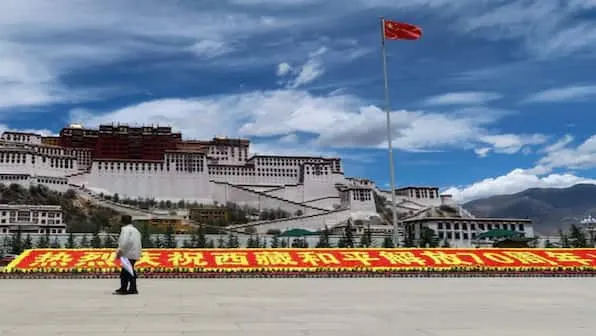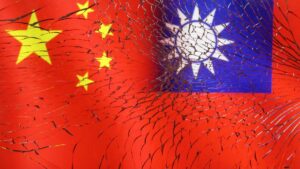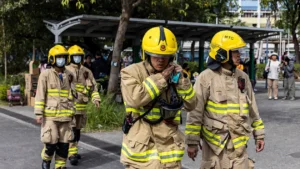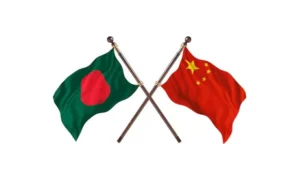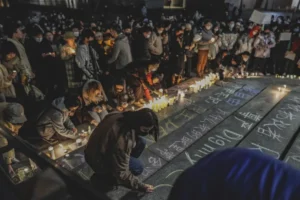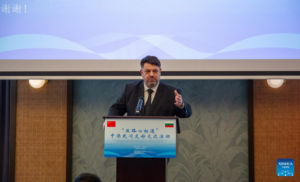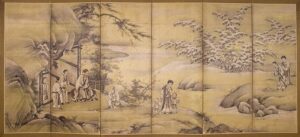Why Relations Between China and Taiwan Are So Tense
Taiwan, officially known as the Republic of China (ROC), is an island separated from China by the Taiwan Strait. It has been governed independently from mainland China, officially the People’s Republic of China (PRC), since 1949. The PRC views the island as a renegade province and vows to eventually “unify” Taiwan with the mainland. In Taiwan, which has its own democratically elected government and is home to twenty-three million people, political leaders have differing views on the island’s status and relations with the mainland.
Cross-strait tensions have escalated since the election of former Taiwanese President Tsai Ing-wen in 2016. Tsai refused to accept a formula that her predecessor, Ma Ying-jeou, endorsed to allow for increased cross-strait ties. Meanwhile, Beijing has taken increasingly aggressive actions, which includes flying fighter jets near the island. Some analysts fear a Chinese attack on Taiwan has the potential to draw the United States into a war with China.
Beijing asserts that there is only “one China” and that Taiwan is part of it. It views the PRC as the only legitimate government of China, an approach it calls the One China principle, and seeks Taiwan’s eventual “unification” with the mainland.
Beijing claims that Taiwan is bound by an understanding known as the 1992 Consensus, which was reached between representatives of the Chinese Communist Party (CCP) and the Kuomintang (KMT) party that then ruled Taiwan. However, the two sides don’t agree on the content of this so-called consensus, and it was never intended to address the question of Taiwan’s legal status. For the PRC, as Chinese President Xi Jinping has stated, the 1992 Consensus reflects an agreement that “the two sides of the strait belong to one China and would work together to seek national reunification.” For the KMT, it means “one China, different interpretations,” with the ROC standing as the “one China.”
Taiwan’s KMT-drafted constitution continues to recognize China, Mongolia, Taiwan, Tibet, and the South China Sea as part of the ROC. The KMT does not support Taiwan’s independence and has consistently called for closer ties with Beijing.
The KMT’s chief rival party, the Democratic Progressive Party (DPP), has never endorsed the understanding laid out in the 1992 Consensus. Former President Tsai refused to explicitly accept the consensus. Instead, she has attempted to find another formulation that would be acceptable to Beijing. In Tsai’s 2016 inaugural address, she noted she was “elected president in accordance with the Constitution of the Republic of China,” which is a One China document, and said she would “safeguard the sovereignty and territory of the Republic of China.” However, Beijing rejected this formulation and cut off official contacts with Taiwan. Tsai’s successor, current DPP leader and Taiwanese Vice President Lai Ching-te, called for reopening dialogue with China to “replace confrontation” during his 2024 presidential election victory speech and pledged to maintain the “cross-strait status quo,” aligned with his party. But experts are skeptical that China will be willing to engage in cross-strait dialogue.
In a 2019 speech, Xi reiterated China’s long-standing proposal for Taiwan: that it be incorporated into the mainland under the formula of “one country, two systems.” This is the same formula used for Hong Kong, which was guaranteed the ability to preserve its political and economic systems and granted a “high degree of autonomy.” Such a framework is deeply unpopular among the Taiwanese public. Pointing to Beijing’s recent crackdown on Hong Kong’s freedoms, even the KMT have rejected the “one country, two systems” framework.
Is Taiwan a member of the United Nations?
No. China rejects Taiwan’s participation as a member in UN agencies and other international organizations that limit membership to states. Taipei regularly protests its exclusion; the United States also pushes for Taiwan’s meaningful participation in such organizations. Amid the COVID-19 pandemic, Taipei criticized the World Health Organization (WHO) for giving in to Beijing’s demands and continuing to bar Taiwan—which mounted one of the world’s most effective responses to COVID-19 in the first two years of the pandemic—from attending the organization’s World Health Assembly as an observer. Ministers from the Group of Seven (G7) countries have called for Taiwan’s inclusion in WHO forums.
Taiwan does, however, hold member status in more than forty organizations, most of them regional, such as the Asian Development Bank and the Asia-Pacific Economic Cooperation forum, as well as in the World Trade Organization. It holds observer or other status on several other bodies.
Only twelve states maintain official diplomatic ties with Taiwan. In March 2023, Honduras severed ties with Taiwan and established relations with China, and in January 2024, just days after Taiwan’s presidential election, so did the Pacific Island nation of Nauru. No government has ever simultaneously maintained formal diplomatic ties with both China and Taiwan.
What is the United States’ relationship with Taiwan?
In 1979, the United States established formal diplomatic relations with the PRC. At the same time, it severed its diplomatic ties and abrogated its mutual defense treaty with the ROC. But the United States maintains a robust unofficial relationship with the island and continues to sell defense equipment to its military. Beijing has repeatedly urged Washington to stop selling weapons to and cease contact with Taipei.
The U.S. approach is governed by its One China policy [PDF]. It is based on several documents, such as three U.S.-China communiqués reached in 1972, 1978, and 1982; the Taiwan Relations Act, passed by the U.S. Congress in 1979; and the recently declassified “Six Assurances” [PDF], which President Ronald Reagan conveyed to Taiwan in 1982. These documents lay out that the United States:
“acknowledges the Chinese position that there is but one China and Taiwan is part of China” and that the PRC is the “sole legal government of China” (some U.S. officials have emphasized that the use of the word “acknowledge” implies that the United States doesn’t necessarily accept the Chinese position);
rejects any use of force to settle the dispute;
maintains cultural, commercial, and other ties with Taiwan, carried out through the American Institute in Taiwan (AIT);
commits to selling arms to Taiwan for self-defense; and
will maintain the ability to come to Taiwan’s defense, while not actually committing to doing so—a policy known as strategic ambiguity.
The United States’ chief goal is to maintain peace and stability in the Taiwan Strait, and it has implored both Beijing and Taipei to maintain the status quo. Washington says it does not support Taiwanese independence.
Through its policy of strategic ambiguity, the United States has for decades attempted to maintain a delicate balance between supporting Taiwan and preventing a war with China. But President Joe Biden has seemingly rejected the policy, stating several times that the United States would come to Taiwan’s defense if China attacked. White House officials have walked back his comments, saying the policy has not changed, but ultimately, the president gets to decide how to respond.
How have recent U.S. administrations approached Taiwan?
Under President Donald Trump, the United States deepened ties with Taiwan over Chinese objections, including by selling more than $18 billion worth of arms to the military and unveiling a $250 million complex for its de facto embassy in Taipei. Trump spoke with Tsai by telephone ahead of his inauguration, the highest level of contact between the two sides since 1979. He also sent several senior administration officials—including a cabinet member—to Taipei, and during his last days in office, the State Department eliminated long-held restrictions governing where and how U.S. officials can meet with their Taiwanese counterparts.
The Biden administration has taken a similar approach, continuing arms sales and affirming the Trump administration’s decision to allow U.S. officials to meet more freely with Taiwanese officials. Biden was the first U.S. president to invite Taiwanese representatives to attend the presidential inauguration. The United States participates in military training and dialogues with Taiwan, regularly sails ships through the Taiwan Strait to demonstrate its military presence in the region, and has encouraged Taiwan to increase its defense spending.
Also, Taiwan has received bipartisan support in Congress over the years, with lawmakers proposing and passing legislation to boost U.S.-Taiwan relations, bolster the island’s defenses, and encourage its participation in international organizations. In August 2022, former House Speaker Nancy Pelosi (D-CA) visited Taipei—the first speaker to do so since Newt Gingrich (R-GA) in 1997—and met with Tsai. Beijing strongly condemned the visit and in response planned military exercises that effectively surrounded the island and banned imports of some fruit and fish from Taiwan, among other actions. Less than a year later, Tsai met with succeeding House Speaker Kevin McCarthy (R-CA) during a March 2023 visit to California. McCarthy was the highest-ranking U.S. official in nearly thirty years to meet a Taiwanese president on U.S. soil, which elicited a similarly strong Chinese response, including condemnation, fresh sanctions, and a show of force in the Taiwan Strait. Following the 2024 Taiwan presidential election, Washington sent a delegation of former government officials to Taiwan to congratulate President-Elect Lai Ching-te and incumbent President Tsai Ing-wen for the DPP’s win and to celebrate the preservation of Taiwan’s democracy.
Could war erupt over Taiwan?
A top concern among U.S. analysts is that China’s growing military modernization and assertiveness, as well as the deterioration in cross-strait relations, could spark a conflict. Such a conflict has the potential to lead to a U.S.-China confrontation. That’s because China hasn’t ruled out using force to achieve Taiwan’s “reunification” and the United States hasn’t ruled out defending Taiwan if China attacks.
However, experts disagree about the likelihood and timing of a Chinese invasion. The top U.S. military commander in the Indo-Pacific warned in 2021 that China could try to invade Taiwan within the next decade [PDF]. Others believe 2049 is a critical date; Xi has emphasized that unification with Taiwan is essential to achieving what he calls the Chinese Dream, which sees China’s great-power status restored by 2049.
Russia’s invasion of Ukraine in early 2022 reignited the debate, with some analysts arguing that Moscow’s moves could embolden Beijing to similarly invade Taiwan and others saying that Beijing could become more cautious after witnessing Russia’s challenges. CFR Fellow David Sacks writes that Russia’s actions won’t influence China’s willingness to use force, but that “Chinese leaders will examine Russia’s failures and adapt their operational plans to avoid making similar mistakes.”
Taiwan likely doesn’t have the capabilities to defend against a Chinese attack without external support, analysts say. Even though Tsai prioritized increasing defense spending, with a record budget of more than $19 billion for 2023, China’s defense spending is still estimated to be around twelve times the size of Taiwan’s. In 2022, Taiwanese lawmakers approved plans to spend an extra $8.6 billion on defense over the next five years. Part of this expanded military budget will go toward acquiring cruise missiles, naval mines, and advanced surveillance systems to defend Taiwan’s coasts. And under Lai’s presidency, there will likely be a continuation of Tsai’s policies, including further increases to the defense budget and the development of the domestic defense industry, writes CFR’s Sacks.
How has China tried to intimidate Taiwan?
China has employed a variety of coercive tactics short of armed conflict, aimed at wearing down Taiwan and prompting the island’s people to conclude that their best option is unification with the mainland. To that end, China has increased the frequency and scale of patrols of PLA bombers, fighter jets, and surveillance aircraft over and around Taiwan. It has also increasingly sailed its warships and aircraft carriers through the Taiwan Strait in shows of force.
Taiwan has reported that thousands of cyberattacks from China target its government agencies every day. These attacks have soared in recent years. In 2020, Taipei accused four Chinese groups of hacking into at least ten Taiwanese government agencies and six thousand official email accounts since 2018 to try to access government data and personal information.
Beijing has also used nonmilitary measures to pressure Taiwan. In 2016, China suspended a cross-strait communication mechanism with the main Taiwan liaison office. It restricted tourism to Taiwan, and the number of mainland tourists visiting Taiwan fell from a high of over 4 million in 2015 to 2.7 million in 2019. After the COVID-19 pandemic, this number plummeted further to 24,000 by the third quarter of 2023. China has also pressured global corporations, including airlines and hotel chains, to list Taiwan as a Chinese province. In addition, China has intimidated countries that have ties with Taiwan: in 2021, China cut off trade with Lithuania for opening a Taiwanese representative office in its capital.
Has Beijing undermined Taiwan’s democracy?
In addition to the tactics described above, China has ramped up interference in Taiwan’s elections. Its methods include spreading disinformation on social media and increasing its control over Taiwanese media outlets. In the 2024 elections, China took its disinformation campaign one step further by working through proxies, such as Taiwanese business elites, to amplify existing local disputes and divisions. The Taiwanese government responded by prosecuting citizens who received funding from China to publish fake news. Such efforts are part of China’s larger strategy of employing coercion to erode trust in Taiwan’s political system and sow divisions in Taiwanese society. However, experts view the DPP’s success in recent elections, and unprecedented third term win, as a rebuke of Beijing.
Taiwan’s democracy is relatively young. The KMT governed under martial law from 1949 to 1987. During that time, political dissent was harshly repressed and Indigenous Taiwanese who had long inhabited the island before 1945 faced discrimination. Taiwan held its first free legislative elections in 1992 and its first presidential elections in 1996. Since then, it has peacefully transferred power between parties several times.
Despite Chinese threats, Taiwan appears to have so far bucked the trend of backsliding afflicting democracies around the world. In 2020, the Economist’s Democracy Index labeled Taiwan a “full democracy” for the first time. In 2022, the index named Taiwan [PDF] the world’s tenth-most-democratic country, ranking it higher than its Asian neighbors (Japan ranked sixteenth and South Korea ranked twenty-fourth) and the United States, which was thirtieth. Recent elections have seen high voter turnout.
Do Taiwanese people support independence?
Most people in Taiwan support maintaining the status quo. A small number support immediate independence, according to opinion polls conducted by National Chengchi University. Even fewer express support for the unification of Taiwan with China. An overwhelming majority reject a “one country, two systems” model, a sentiment that has grown as Beijing cracks down on Hong Kong’s freedoms.
An increasing number of Taiwanese people feel more closely tied to Taiwan than to the mainland. Nearly 63 percent of the island’s residents regarded themselves as exclusively Taiwanese, a June 2023 survey by National Chengchi University found. By comparison, around 31 percent identified as both Taiwanese and Chinese, down from 40 percent a decade earlier. Only about 3 percent considered themselves only Chinese, a view that has become less popular since 1994, when 26 percent identified that way.
What is Taiwan’s economic situation?
Taiwan’s economy remains reliant on trade with China, which is the island’s largest trading partner. However, their economic relationship has experienced disruptions in recent years, partly due to Beijing’s pressure on the island and Taiwanese officials’ growing concern about its overreliance on trade with China.
Under President Ma, who was in office from 2008 to 2016, Taiwan signed more than twenty pacts with the PRC, including the 2010 Cross-Straits Economic Cooperation Framework Agreement [PDF], in which they agreed to lift barriers to trade. China and Taiwan resumed direct sea, air, and mail links that had been banned for decades. They also agreed to allow banks, insurers, and other financial-service providers to work in both markets.
Tsai and the DPP, on the other hand, have attempted to diversify Taiwan’s trade relationships, with mixed results. Tsai has had some success boosting trade with and investment in countries in Southeast Asia and the Indo-Pacific through a signature initiative, the New Southbound Policy. Trade between Taiwan and the eighteen targeted countries nearly doubled between 2016, when the initiative was unveiled, and 2022. Taiwanese investment in those countries has also steadily increased. In 2019, Tsai unveiled a three-year plan to incentivize Taiwanese manufacturers to move from the mainland back to Taiwan.
Still, in 2021, Taiwan’s exports to China hit an all-time high. Beijing has pressured countries not to sign free trade agreements with Taiwan. A handful of countries have signed free trade pacts with the island; New Zealand and Singapore are the only developed economies to sign such agreements. Beijing has also pushed for Taiwan’s exclusion from multilateral trading blocs, including the Comprehensive and Progressive Agreement for Trans-Pacific Partnership (CPTPP) and the Regional Comprehensive Economic Partnership (RCEP). (China is included in the RCEP but not in the CPTPP.) Taiwan also is not part of the Biden administration’s Indo-Pacific Economic Framework.
Have cross-strait tensions hurt Taiwan’s vital semiconductor chip manufacturers?
Taiwan is the world’s top contract manufacturer of semiconductor chips, and its industry is booming despite cross-strait tensions. These chips are found in most electronics, including smartphones, computers, vehicles, and even weapons systems that rely on artificial intelligence. Companies in Taiwan were responsible for more than 60 percent of revenue generated by the world’s semiconductor contract manufacturers in 2022.
Much of that can be attributed to Taiwan Semiconductor Manufacturing Company (TSMC), the world’s largest contract chip maker and the top supplier for Apple and other U.S. companies. It is one of only two companies in the world (the other is South Korea-based Samsung) that has the technological know-how to make the smallest, most advanced chips, and it manufactures more than 90 percent of them.
Some experts argue that the United States’ dependence on Taiwanese chip firms heightens its motivation to defend Taiwan from a Chinese attack. Recognizing the extent to which the United States relies on TSMC for critical chips, Biden has pushed to strengthen the U.S. chip industry; in August 2022, Congress passed a sweeping $280 billion bill to encourage domestic chip manufacturing. This included subsidies for TSMC to build a chip plant in Phoenix, Arizona, with production scheduled to begin in early 2025. The Biden administration followed that legislation with stringent export controls that restrict China’s ability to obtain advanced chips, including from TSMC. Experts say these constraints could hamstring China’s technology sector—prior to the export controls, China purchased about 70 percent of its chips from TSMC. Beijing is now working to boost its own chips industry, including through expanded production by Huawei, a Chinese telecommunications giant that Washington claims Beijing could use for espionage.
